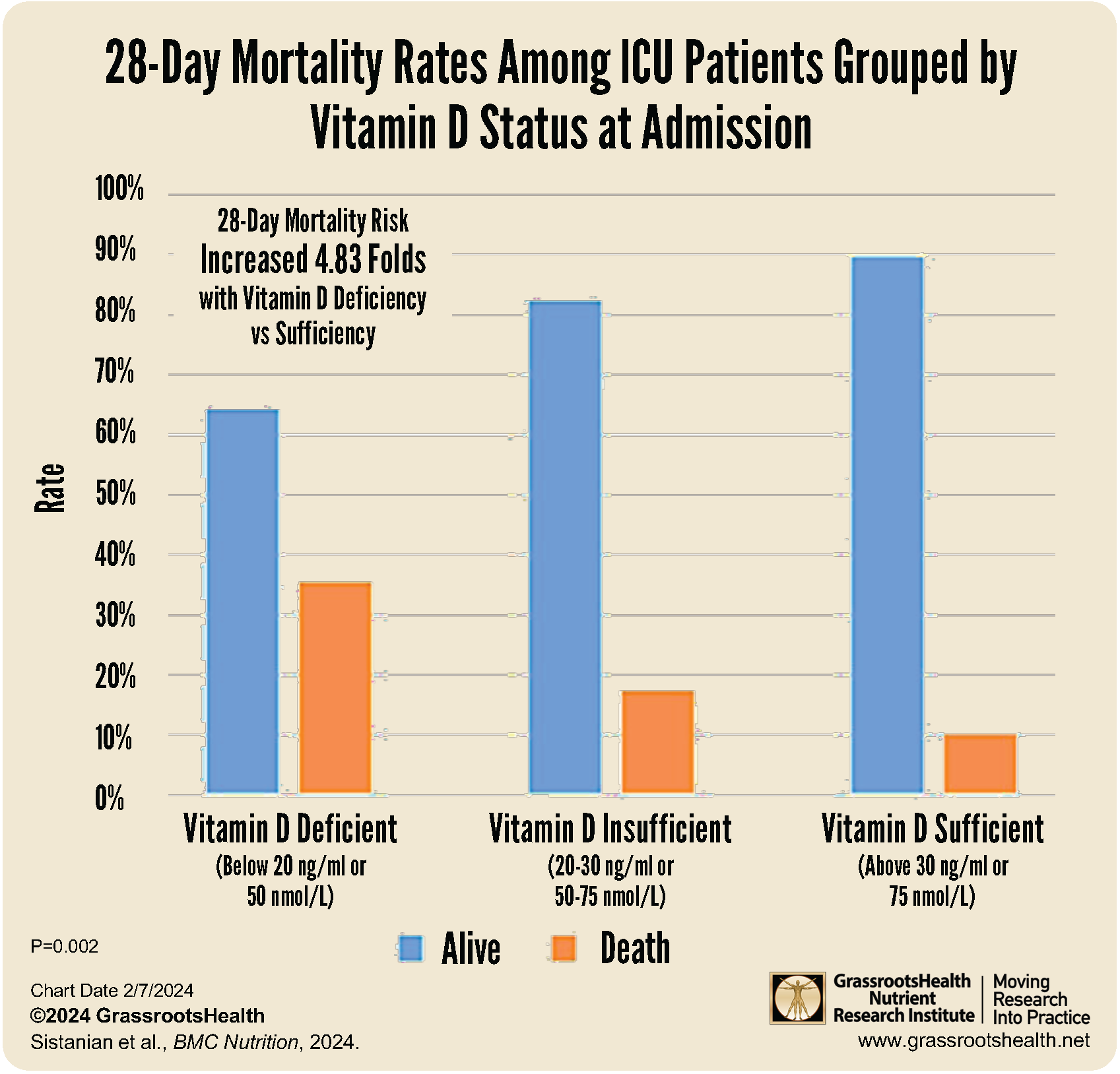Published on February 9, 2024
Vitamin D deficiency upon ICU admission shown to increase 28-day mortality risk by over 4-fold, worse post-surgical outcomes also associated with low vitamin D status
Key Points
- A study of 236 intensive care unit (ICU) patients found that 69% of patients were vitamin D deficient (with vitamin D levels below 20 ng/ml or 50 nmol/L) upon admission, which in turn was associated with higher degrees of disease severity and organ dysfunction
- The study also found that the risk of 28-day mortality was increased 4.83 folds for those with vitamin D levels below 20 ng/ml compared to those with vitamin D levels above 30 ng/ml
- A systematic review found that 26 out of 31 studies found that low perioperative vitamin D levels were associated with at least one statistically significant adverse post-surgical outcome, including increased risk of infection, increased risk of cancer, and an increased risk of mortality after surgery
 Please share the following information for Sepsis Survivor Week, February 11-17th.
Please share the following information for Sepsis Survivor Week, February 11-17th.
Vitamin D deficiency among hospital patients with acute conditions has been associated with an increased risk of adverse outcomes, including infections, the progression of sepsis and acute respiratory distress syndrome (ARDS), and increased mortality. One previously reviewed study concluded that vitamin D deficiency was a risk factor for the development of sepsis and found that significantly lower levels of vitamin D were associated with a lower chance of survival during hospital care.
Vitamin D deficiency is very easy to identify and address, and achieving and maintaining sufficient vitamin D levels is a low-cost, safe, and highly effective way to help improve overall health and decrease disease risk – whether receiving hospital care, preparing for surgery, or neither.
Measure Your Vitamin D Levels Here Today
4-Fold Increased Risk of Death within 28 Days if Vitamin D Deficient vs Sufficient upon Admission to ICU
A new 2024 publication by Sistanian et al. reported findings from a study of 236 intensive care unit (ICU) patients, from seven ICUs in 3 different hospitals, looking at the association between vitamin D status, clinical outcomes, and mortality. The average age of patients was 45 years old. Vitamin D levels were drawn within the first 24 hours of admission.
69% of patients were vitamin D deficient (with vitamin D levels below 20 ng/ml or 50 nmol/L) upon admission.
Vitamin D deficiency was significantly associated with
- higher disease severity, as measured with the APACHE II score (acute physiologic assessment and chronic health evaluation)
- higher degrees of dysfunction of the 6 major organ systems, as measured with the SOFA score (sequential organ failure assessment)
- higher nutritional risk assessment, as measured by the mNUTRIC score (Nutrition Risk in the Critically Ill Score)
Those with vitamin D levels below 20 ng/ml were also kept on mechanical ventilation longer, had a longer ICU stay, and were also at a significantly greater risk of death within 28 days of hospitalization (OR: 4.83). In other words, the risk of 28-day mortality was increased 4.83 folds for those with vitamin D levels below 20 ng/ml compared to those with vitamin D levels above 30 ng/ml!

The chart above shows the comparison of survival and mortality rates between those with vitamin D deficiency, insufficiency, and sufficiency.
The study also found that patients whose vitamin D levels were above 30 ng/ml (75 nmol/L) upon admission had a significantly shorter ICU stay along with better outcomes.
“According to the findings, vitamin D deficiency increased the risk of 28-day mortality by 4.83 folds compared to normal vitamin D levels… Vitamin D deficiency was identified as an independent predictor of 28-day mortality.”
Systematic Review Finds Better Surgical Outcomes with Higher Vitamin D Levels
A 2015 systematic review by Iglar PJ and Hogan KJ looked at the association of vitamin D status with post-surgical outcomes, based on data from 31 studies and 16,195 individuals in total. 26 out of the 31 studies found that low perioperative vitamin D levels were associated with at least one statistically significant adverse post-surgical outcome.
Findings from individual studies included in the review were as follows:
- Ducloux et al. tracked kidney transplant patients for 24 months and found an 8% increased risk of cancer after kidney transplantation for each 1 ng/ml decrease in vitamin D level, and a 4-fold greater risk of cancer overall among patients with low vitamin D
- Falkiewiscz et al. tracked kidney transplant patients for 24 months as well and found an 8-fold greater risk of delayed renal graft failure with perioperative vitamin D deficiency
- Quraishi et al. tracked gastric bypass patients and found a 3-4 fold greater risk of hospital acquired and surgical site infections among those with preoperative vitamin D levels below 30 ng/ml
- Lowery et al. tracked lung transplant patients for 12 months and found a 3-fold greater mortality rate in the first year after the procedure among patients with low vitamin D status close to the time of surgery, as well as increased risk of acute cellular rejection and bacterial, viral and fungal infection
Have you checked your vitamin D levels lately?
Test Your Vitamin D Levels Here with Other Important Measurements Today
How Are Your Levels of Omega-3s, Magnesium, Vitamin D and CRP?
Do you know what your Omega-3 status is? Or what your inflammation levels are? Check yours along with your vitamin D and magnesium levels today as part of the vitamin D*action project, and add the Ratios for more about how to balance your Omega-3s and 6s!
Measure your:
- Vitamin D
- Magnesium PLUS Elements
- Omega-3 Fatty Acids
- hsCRP (for Inflammation)
- HbA1c (for Blood Sugar)
- and more
Did you know that each of the above can be measured at home using a simple blood spot test? As part of our ongoing research project, you can order your home blood spot test kit to get your levels, followed by education and steps to take to help you reach your optimal target levels. Start by enrolling and ordering your kit to measure each of the above important markers, and make sure you are getting enough of each to support better mood and wellbeing!
Build your custom kit here – be sure to include your Omega-3 Index along with your vitamin D.
Start Here to Measure Your Levels






